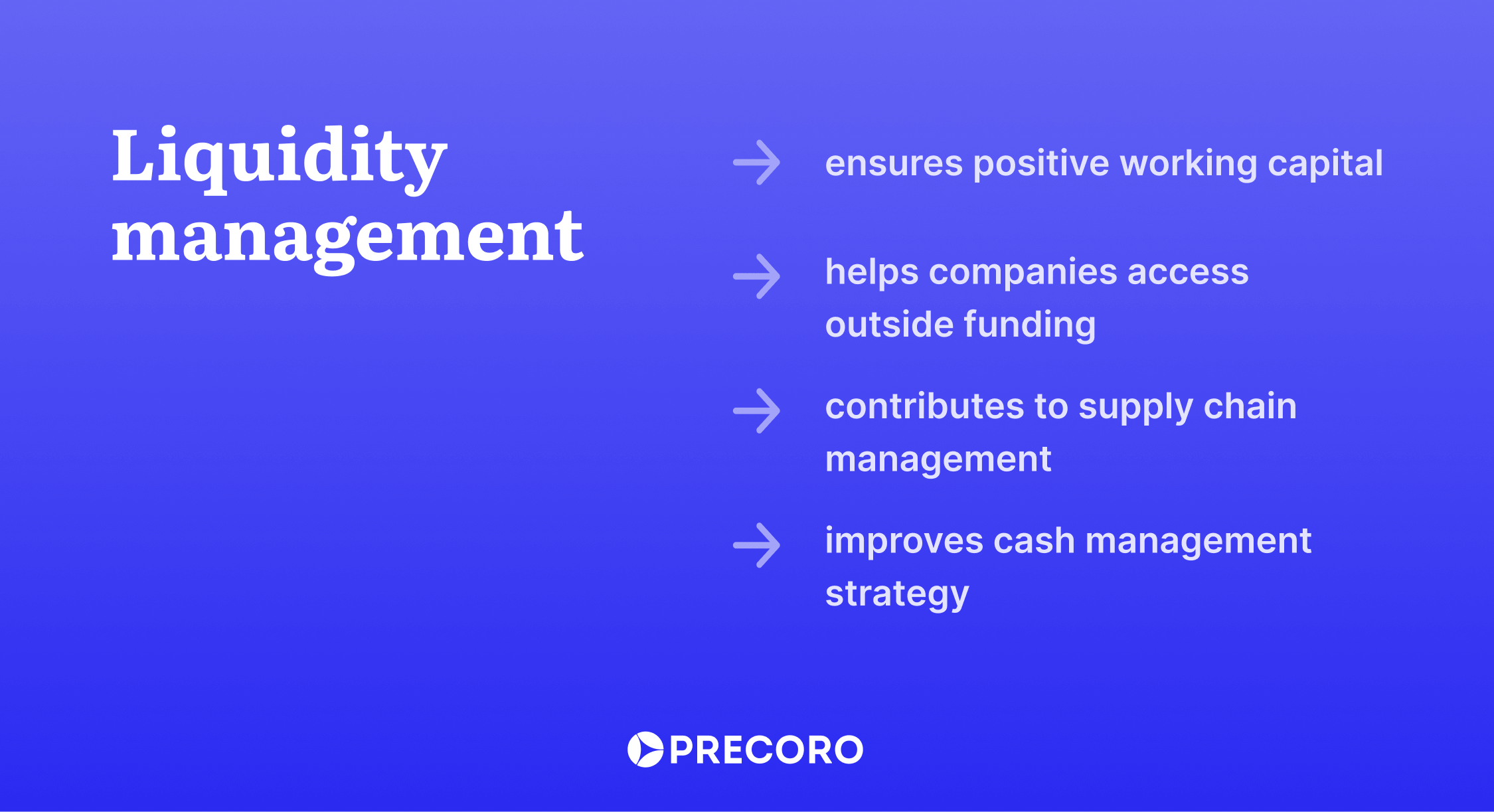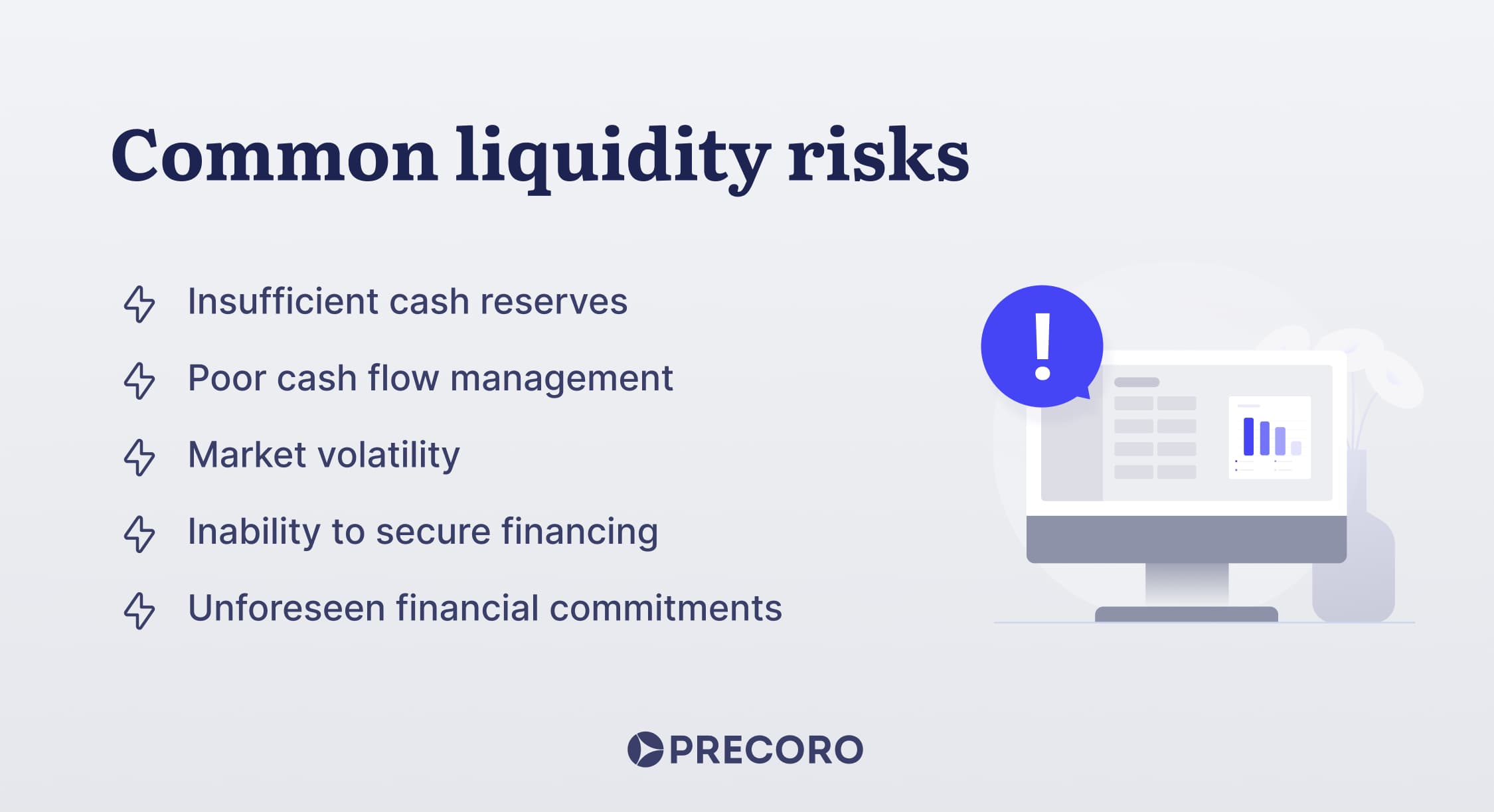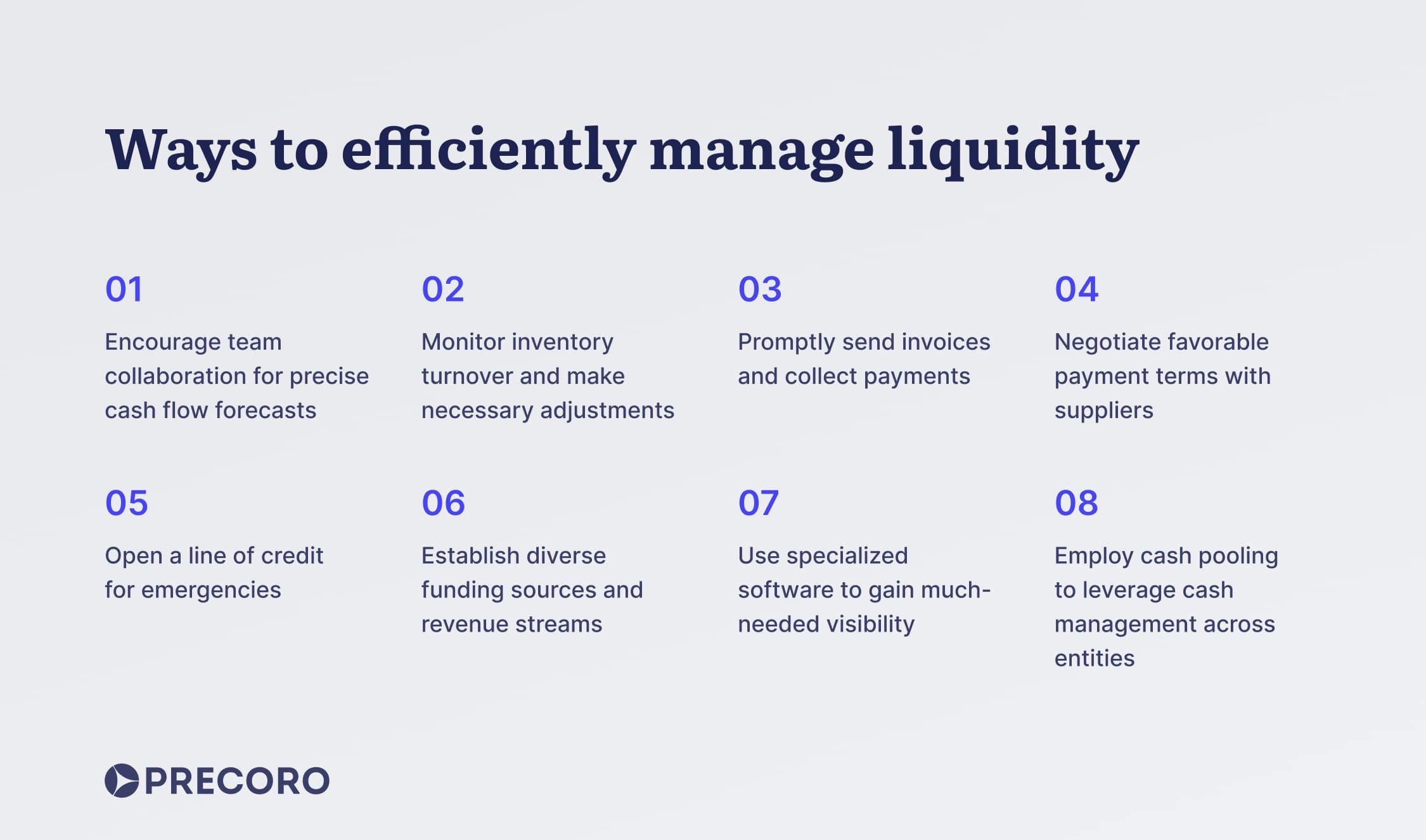
14 min read
Liquidity Management: Importance, Risks, and Best Practices
Liquidity management is a must-have practice for a company to meet its financial obligations. Learn how to measure liquidity and tips for improving it.
According to the 2022 Deloitte Global Treasury Survey, CFOs consider improving liquidity risk management to be a top priority for their treasury departments. But why is liquidity management so important? The answer is simple — it helps companies meet short-term obligations while positioning for long-term growth and success.
In this article, we uncover the essential practices that empower organizations to address liquidity challenges and capitalize on strategic opportunities proactively. You’ll learn how liquidity impacts working capital and the role it plays in attracting outside funding, understand liquidity ratios, and discover the best practices for building a liquidity management strategy.
Keep reading to learn:
- Liquidity management definition
- The importance of liquidity management
- How companies assess liquidity
- Common liquidity risks
- Ways to efficiently manage liquidity
- Frequently Asked Questions
Liquidity management definition
Liquidity refers to a company’s ability to easily convert its assets into cash and promptly pay off its debts and short-term liabilities. Some assets, known as liquid assets (e.g., cash in the bank, money that customers owe), can be swiftly converted into cash on hand. However, others, like fixed assets (e.g., property, equipment), may take longer, and selling them hastily could result in a loss of value.
Thus, to understand their liquidity, companies need to know how quickly they can turn their short-term assets into cash as well as when their medium- and long-term assets will pay off. Objectives of liquidity management are to ensure that the business has cash on hand to fulfill its financial obligations and weather the storm during both anticipated and unexpected events, like supply chain disruption or abrupt drop in sales, without enduring significant losses.
Furthermore, liquidity helps companies determine whether they’re ready to make investments to increase their turnover. For this purpose, the finance and treasury departments develop a strategy of making sufficient cash available without jeopardizing the company’s ability to meet its financial obligations.
Managing liquidity involves two key steps: cash flow monitoring and cash flow planning. The first step requires an overview of income and expenditure in real time. It’s also important for a company to access historical cash inflows and outflows to understand the impact of seasonality or market fluctuations and recognize patterns of expenditure and revenue generation.
In the second step, cash flow planning, it’s important to use the insights from cash flow monitoring to create a plan of estimated expenses and income. In order to make it as realistic as possible, it’s a good idea for treasury and finance departments to communicate closely with sales, procurement, and accounting teams.
The importance of liquidity management
Liquidity management plays a significant role in various processes. Let’s explore how.

Ensuring positive working capital
First and foremost, liquidity directly impacts a company’s working capital. A positive working capital signals good financial health, as it indicates the business has more assets than liabilities. Conversely, a negative working capital comes with the risk of defaulting on financial obligations, as liabilities outweigh assets.
Efficient liquidity management ensures companies maintain sufficient cash reserves to cover short-term liabilities and operational expenses. It is achieved through strategic investments in assets or initiatives that can generate returns in the short term. As for medium and long-term assets, liquidity management helps businesses align the maturity of investments as closely as possible with upcoming obligations.
Accessing outside funding
Efficient liquidity management is particularly important for businesses seeking loans or additional external funding, as both investors and creditors closely examine liquidity to determine whether giving money to a business is a good opportunity or a risk. Lenders assess a company’s liquidity position to ensure it can repay its loans as scheduled; meanwhile, investors want to determine whether the company manages its cash flow effectively and has the flexibility to navigate unforeseen challenges or capitalize on strategic opportunities.
Contributing to supply chain management
Disruptions in the supply chain pose significant business challenges and can potentially result in increased costs, decreased sales, and lower profits. To mitigate these risks, companies rely on liquidity management strategies and establish emergency funds to cover unexpected expenses and maintain lines of credit. Thus, liquidity is critical to overall risk management and business resilience.
Improving cash management strategy
Liquidity management empowers finance teams to strategically allocate funds where they’re most needed or useful. For example, the CFO might notice that funds tied up in low-interest savings accounts could be strategically moved to investment opportunities offering better growth prospects.
As liquidity management requires total visibility into financial data, it helps companies create more accurate scenario analysis and cash forecasting. Thus, it guides important financial decisions, such as whether to invest in expansion or new projects or whether a lender will approve a loan for your organization.
How do companies assess liquidity?
There’s a toolkit of metrics to help the treasury department understand the level of liquidity. All of them are based on current assets and current liabilities. Current assets are those that the company expects to use up within the next 12 months. They encompass cash reserves, accounts receivable, inventory, and marketable securities.
Current liabilities are debts or bills that a company owes within the next 12 months. They include accounts payable, wages, bank loans, dividends payable, interest payable on outstanding debts, and income taxes due within the year. Let’s see how exactly these indicators can be used in ratios that represent liquidity.
Current ratio
This method is the most straightforward and widely used approach to assess a company’s liquidity. It compares the company’s current assets against its current liabilities, indicating its capacity to settle short-term debts within a year. The formula is the following:
Current Ratio = Current Assets / Current LiabilitiesQuick ratio
This calculation is very similar to the current ratio but excludes inventories from its current assets. It’s employed because converting inventory into cash may require time and could be unavailable for immediate use to fulfill short-term obligations. Consequently, companies with substantial inventory holdings typically exhibit lower-than-average quick ratios. The ratio is calculated in the following way:
Quick Ratio = Cash + Marketable Securities + Accounts Receivable / Current LiabilitiesCash ratio
This calculation evaluates the company’s capacity to fulfill short-term obligations using its most readily available assets — cash and cash equivalents. It is calculated as:
Cash Ratio = Cash / Current LiabilitiesA higher ratio in all three formulas means the company is better prepared to meet its financial obligations.
Net working capital
As we mentioned above, working capital reflects a company’s liquidity. Thus, net working capital can be used to see whether the company’s current assets are enough to pay its current liabilities without the external capital. Positive working capital signals good liquidity. The metric is calculated by subtraction:
Net Working Capital = Current Assets – Current LiabilitiesDays Sales Outstanding (DSO)
While it isn’t a comprehensive liquidity metric, DSO is still useful to see whether the company promptly collects client payments after making a sale. A high DSO means a company is tying up capital in receivables as it takes too long to collect payments. However, what constitutes a standard DSO value depends on industry and company size. The formula is:
Days Sales Outstanding = Accounts Receivable / Revenue per DayCommon liquidity risks
Corporate liquidity management challenges can have severe consequences that affect the ability of businesses to meet their short-term financial obligations. The 2022 Bloomberg Risk Analytics Survey states that market, credit, and liquidity risks were top-of-mind concerns for financial institutions for 2023. Let’s explore common liquidity risks in more detail:

Insufficient cash reserves
A company suffers from insufficient cash reserves when it fails to maintain enough liquid assets to cover unexpected expenses, such as equipment repairs or regulatory fines. This risk can arise from poor financial planning, high operational expenses, or missed sales targets.
Poor cash flow management
Bad liquidity management, particularly inaccurate revenue forecasts, a lack of visibility into billing and collection processes, or overly ambitious expansion plans, affect the company’s ability to efficiently manage its cash flow. As a result, the firm may miss the payment deadline, miss early payment or bulk discounts, and make untimely investments.
Market volatility
Market volatility refers to fluctuations in financial markets, interest rates, or exchange rates that can significantly impact the value of a company's assets and its access to financing. Factors such as macroeconomic conditions, geopolitical events, or shifts in investor sentiment can contribute to market volatility.
Inability to secure financing
Companies may face difficulty securing additional financing if they have late debt repayments or non-compliance with loan agreement covenants. These cause relationships with lenders to become strained, making it challenging to obtain the necessary funding. This, in turn, may compel a company to sell assets at a loss to capitalize on strategic opportunities or pay off obligations.
Unforeseen financial commitments
When a company has limited visibility into its own financial position, it can lead to the oversight or underestimation of certain financial commitments, such as one-time payments, legal liabilities, or contingent obligations. Such expenses can deplete cash reserves, compromising the company’s ability to pursue growth opportunities or weather economic downturns.
Ways to efficiently manage liquidity
Sound liquidity management comes down to having enough cash on hand – or the ability to quickly convert assets into cash without substantial losses – to meet financial obligations as they arise. Minimizing expenses and raising prices may be the most obvious ways to regulate liquidity risks, but there are other approaches.

Encourage team collaboration for precise cash flow forecasts
Estimates bring value only if they closely reflect reality. For a treasury or finance department to make a reliable cash flow forecast, they should establish communication with sales, procurement, and accounts payable teams. Smooth collaboration can bring the following benefits:
-
Effective communication with the procurement department provides valuable insights into the company’s purchasing patterns, preferred suppliers, and essential items. By analyzing historical and current procurement activities, the finance team can develop a realistic forecast of expenses. Discussing upcoming procurement needs and budget constraints enables the treasury to integrate cash outflows into cash flow forecasts, ensuring sufficient funds for future purchases and operational expenses.
-
Timely and transparent communication with the AP department is essential for the treasury team to understand accounts payable balances, payment schedules, and cash disbursement. Additionally, collaborating with accounts payable allows the treasury team to optimize payment timing strategies based on liquidity considerations, such as extending payment terms or maximizing Days Payable Outstanding to preserve available cash.
-
Close collaboration between the finance and sales teams enables sharing of market insights, customer trends, and sales projections. This way, the finance team can better anticipate future revenue streams and cash inflows by aligning sales forecasts with financial planning.
Moreover, close cooperation with other departments and real-time monitoring of their activities can help the finance team identify liquidity gaps that need to be addressed. For example, finance may notice that accounts payable (AP) are increasing, but accounts receivable (AR) are staying the same. This could indicate that the organization has difficulty collecting payments from customers. Later in the article, we’ll delve deeper into how optimizing AP and AR can improve liquidity management.
Monitor inventory turnover and make necessary adjustments
Managing inventory levels can be tricky: too much inventory ties up working capital, while too little jeopardizes sales opportunities. That’s why it’s important to closely monitor inventory performance and observe which products are selling and which are slow to move. When you have that information, the decision to eliminate or reduce the amount of slow-moving inventory can be made, and it will free up more cash.
Businesses can also implement just-in-time inventory management. This approach synchronizes inventory levels with customer demand; goods are ordered only as they are needed during the production or distribution process. If applied carelessly, this approach could result in a sudden lack of supplies, but if the company monitors inventory closely, such risks are minimal.
Moreover, for companies that resell goods and don’t have a lot of space available to store large amounts, it might be possible to take a drop-shipping approach. With drop-shipping, the original manufacturer or wholesaler sends products directly to the end customers; this way, the selling company doesn’t have to physically store the goods, and can concentrate its funds on marketing and sales. When possible, switching to drop-shipping can improve cash flow immediately.
Promptly send invoices and collect payments
The faster you send invoices after a product is delivered or service rendered, the faster your customers will pay. Organizations can optimize invoicing by utilizing software to automate billing tasks.
It’s also helpful to send payment reminders as the due date approaches. Late payers should receive follow-up reminders, and no further shipment of products should be sent to them until all past-due amounts have been collected. To minimize such cases, companies can choose to include a late-payment clause that adds a penalty fee for late payments.
Another useful tactic to get customers to pay on time is to offer a small discount for early payment. Offering incentives for early payment may incur initial costs but can mitigate cash flow issues and eliminate the need for follow-up on late payments, thereby saving resources. Companies can also require customers to pre-pay for orders. This is especially useful when undertaking a big order that requires a lot of up-front costs.
Negotiate favorable payment terms with suppliers
If a company always receives payments from clients at the very end of the deadline and needs to pay suppliers immediately upon receiving invoices, then cash flows will consistently exceed inflows, creating a perpetual liquidity challenge. To improve the situation, it is helpful not just to motivate the clients to pay earlier but also to negotiate more favorable payment terms with the vendors.
Meanwhile, if liquidity is a concern, paying your suppliers closer to the invoice due date, rather than earlier, can help. Businesses can also ask suppliers or vendors about early payment incentives to capitalize on cost-saving opportunities, if available. Or, if there is a good relationship, suppliers may even be open to offering a discount for bulk orders.
Open a line of credit for emergencies
Organizations should think about how they can address cash flow gaps and cover unexpected costs without disrupting their operations. Even if the business currently has sufficient liquid assets, having a line of credit available from a bank or financial institution is wise, as it provides a safety net in case cash flow becomes constrained.
Unlike term loans that offer a lump sum upfront, a line of credit provides borrowing flexibility. Businesses can access funds as required, up to the approved limit, and pay interest solely on the borrowed amount. Thus, a line of credit can serve as a valuable cash management tool, helping businesses smooth out cash flow fluctuations and manage seasonal or cyclical variations in revenue and expenses.
Establish diverse funding sources and revenue streams
Establishing diversified streams of cash inflow may be easier said than done, but it’s a very useful way to improve the liquidity management process. This strategy requires the company to spend early on, so it should be implemented before the company faces any liquidity issues. A company can diversify its financial resources through several strategic initiatives:
- Going beyond traditional bank loans and exploring alternative financing options such as venture capital, private equity, angel investors, crowdfunding platforms, and peer-to-peer lending.
- Collaborating with strategic partners to create joint ventures, strategic alliances, and co-branding initiatives.
- Expanding product lines or service offerings to cater to diverse customer segments and capture new market opportunities. Usually, this requires investing in research and development (R&D) initiatives.
- Expanding into new markets through international expansion, regional diversification, or online marketplaces to broaden the customer base and unlock new growth avenues. This tactic reduces dependence on specific markets.
While all the above-mentioned strategies will help organizations improve their liquidity levels and establish a safety net in case of unexpected downfall, it’s especially important to focus on expanding liquid assets that can be easily converted into cash. This can be done by allocating funds to money market accounts, short-term certificates of deposit (CDs), and treasury securities.
Use specialized software to gain much-needed visibility
Ultimately, to improve the liquidity management process, companies need impeccable visibility into their cash position. This allows them to more easily identify trapped cash, such as excess inventory, uncollected accounts receivable, maverick spending, and purchases exceeding the budget.
Many companies rely on a spreadsheet approach to the liquidity management process, manually entering transactions as they occur. This method has several major drawbacks: it’s time-consuming, prone to errors, and the cash flow table is often outdated since cash flows fluctuate daily.
For better visibility and clearer data, companies can use dedicated liquidity management software solutions. These specialized systems display the cash flow in real time by connecting to the company’s bank accounts, automatically retrieving the transactions from there, and adjusting the cash flow forecasts with the latest information. Additionally, users can employ such tools to generate financial and performance plans based on the company’s structure, resources, and budgets.
According to Ryan Maupin, a Deloitte Risk & Financial Advisory managing director and U.S. turnaround and restructuring leader, Deloitte Transactions and Business Analytics LLP, many of the polled executives from the 2023 Deloitte poll see that “the overall cost savings and operational benefits of adopting next-generation liquidity planning solutions typically outweigh the cost of investment, with many organizations achieving cost reductions, labor efficiencies, and, ultimately, more accurate downturn planning.”
Additionally, a company may use a procurement tool to gain visibility and control over inventory, budgets, expenses, invoices, and orders. For example, Precoro lets stakeholders get the information needed to build the forecast, as each expenditure is documented in the system. Plus, it allows departments to track their spending in real time and prevent overspending by setting up alert notifications when the PO exceeds the budget limit.
Implementing a procurement tool is especially useful if it has integrations with ERP software and other business systems. Transactions will seamlessly migrate between systems, and procurement, finance, and accounting teams will be on the same page. Moreover, Precoro offers dashboards and a customizable report builder that together provide leaders across the organization with meaningful cash flow metrics.
Employ cash pooling to leverage cash management across entities
A cash pool is a liquidity management technique that consolidates funds from multiple accounts across different subsidiaries, departments, or geographic locations into a central account. This way, the business can transfer funds from accounts with surplus cash (credit positions) to those with deficits (debit positions).
Cash pooling allows companies to maximize interest income or minimize interest expense by consolidating funds in accounts that offer favorable interest rates. One more benefit is that it reduces the administrative burden associated with monitoring multiple accounts and transferring funds between them manually.
There are different types of cash pooling structures, including:
- Notional pooling, which is a virtual pooling of balances without physical movement of funds, where interest is calculated on the net position of the accounts.
- Zero balance pooling, which involves the daily transfer of funds from subsidiary accounts to a master account while maintaining a zero balance in subsidiary accounts to minimize idle cash.
- Target balancing pooling, which entails transferring funds to maintain predetermined target balances in subsidiary accounts. When the determined amount is exceeded, the excess cash is swept into the master account.
Overall, cash pooling offers companies a strategic mechanism to centralize cash resources and improve overall financial efficiency. However, it’s essential for businesses to carefully assess the regulatory, tax, and operational implications of implementing cash pooling structures to ensure compliance and maximize benefits.
It’s also easier to perform cash pooling when the organization does in-house banking. A company with an in-house bank can use its own resources to carry out the functions an external bank normally would, such as controlling all of its subsidiaries’ accounts or determining company specific lender and borrower terms.
Frequently Asked Questions
Liquidity management is the ongoing process of overseeing and optimizing the company’s ability to fulfill both short-term responsibilities, like covering expenses and payroll, and long-term commitments, such as loan repayments and strategic expansion.
Effective liquidity management enables organizations to maintain sufficient cash and liquid assets to meet both expected and unforeseen financial commitments. When liquidity is managed poorly, companies may resort to high-interest borrowing or hasty asset sales at unfavorable prices to raise funds during times of need, which can negatively affect their bottom line.
Approach liquidity management thoughtfully
Liquidity management is an efficient way to weather the storm in the face of economic crises, market fluctuations, or supply chain disruptions that can put companies out of business. Interestingly, an organization can go under even if its assets exceed its liabilities, but it fails to convert its assets into cash when needed.
Having a good liquidity management strategy helps companies have positive working capital and efficient cash flow. In addition to helping organizations meet debt obligations with their liquid assets, good liquidity also helps businesses attract investors and gain the trust of lenders.
Liquidity risk refers to the financial hazard arising from a company’s incapacity to settle its financial obligations promptly. Businesses are more prone to liquidity risks when they have insufficient cash reserves and poor cash flow management. Ultimately, maintaining proper levels of business liquidity is dependent on having a clear view of assets, expenses, and upcoming obligations.
That’s why an effective liquidity management strategy usually involves implementing a specialized tool. Liquidity management software helps treasurers forecast cash flows, manage bank accounts, optimize cash balances, and identify liquidity gaps. Additionally, it’s a good idea to adopt a procurement system so that all orders, expenses, and budgets are under control within a single platform and visible to all stakeholders.
Other best practices for managing liquidity include encouraging team collaboration, optimizing inventory turnover, opening a line of credit, and establishing a diversified mix of cash inflows. Additionally, it’s important to optimize payment from clients and suppliers, namely, to incentivize customers to pay earlier and negotiate favorable payment terms with suppliers to pay them later.









